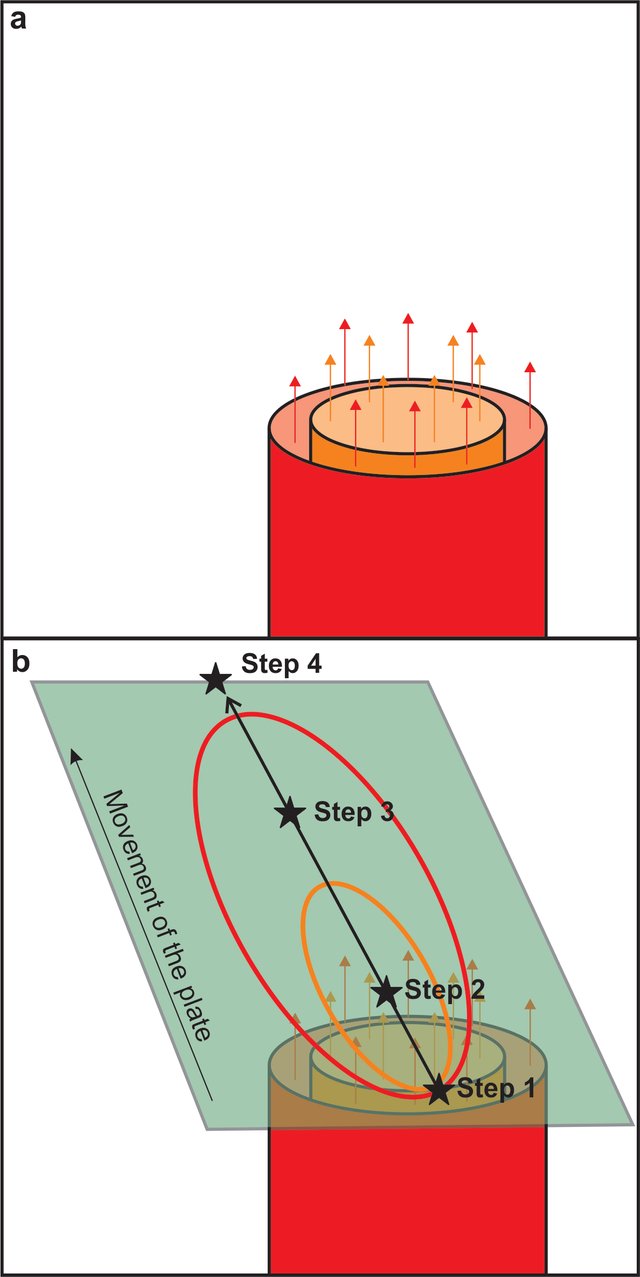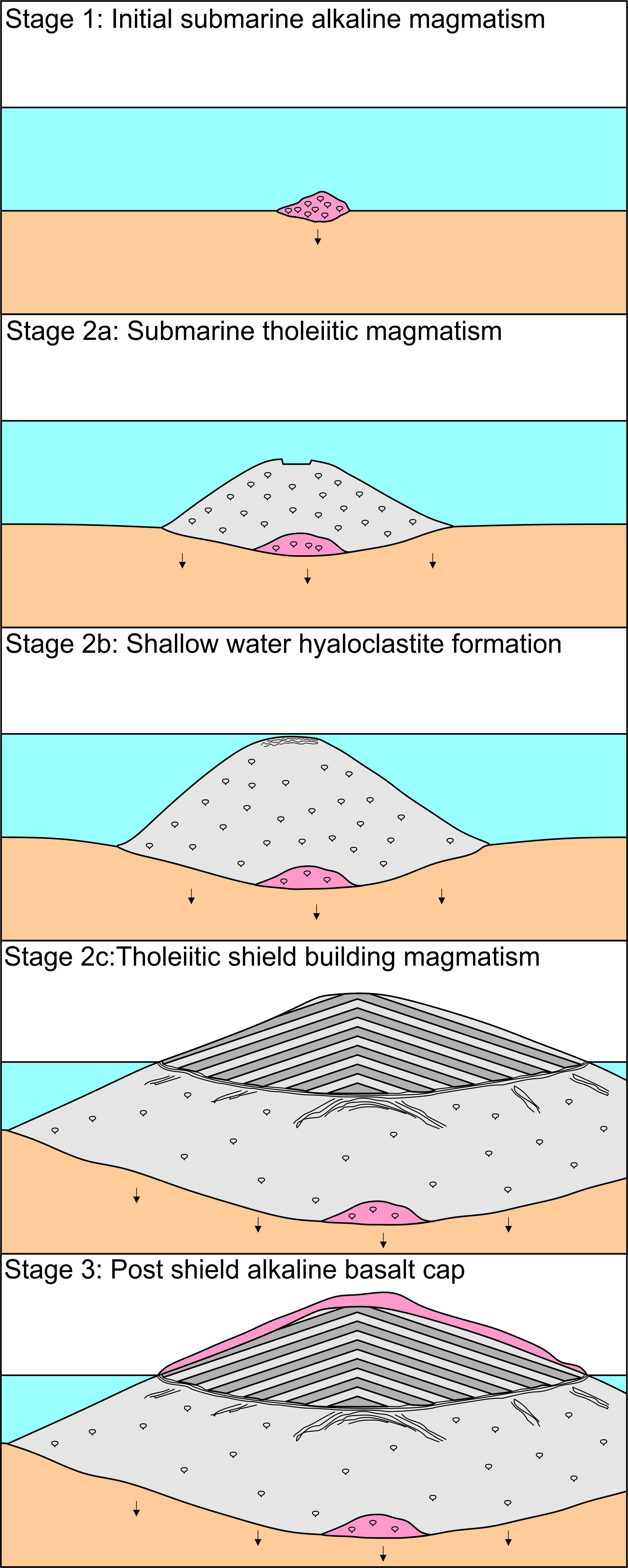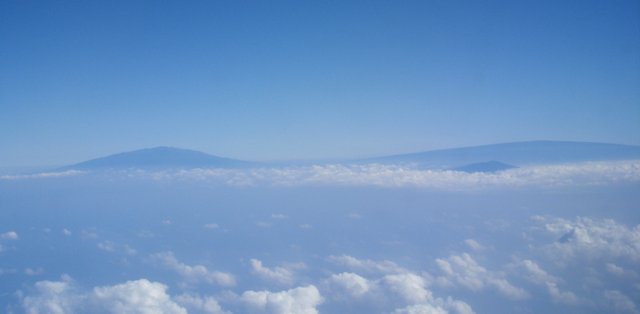Hawaiian volcanoes - Part 3: A growing volcano
Hello Everyone,
In today’s part I will to talk about the growth and composition of Hawaiian volcanoes.
This begins with the observations we can make on land. Walking across the Islands of Hawaii, geologist noticed that the lower parts of Hawaiian volcanoes consist of relatively thin lava flows that tend to weather to a red-brown color. The upper parts, on the other hand, consist of fewer, but thicker, lava flows that typically weather to a light grey or white color. The deposition of soil layers between the uppermost thin flows and the lowermost thick flows indicate that some time must have passed in between those two eruption styles.

Figure 1.Plateau on Maui showing the difference between the lower part weathering brownish/reddish and the upper part, forming thicker layers which weather greyish.
pxhere.com
Generally this means: The volcano erupts once, producing a single type of lava. Then it pauses for a while, during which time the soil evolves. Then it erupts again, but producing a different kind of lava.
So why would a Hawaiian volcano change its lava type?
This is caused by the moving plate on top of a plume!
To understand how the interaction from the plume with the moving plate above it influences magma composition we first need to take a closer look at the plume itself.
The plume appears when hotter, more buoyant mantle material is traveling upwards through the adjacent mantle. It rises as a defined column with a slightly widened head. During this whole process the mantle stays solid. The plume column does not rise at the same rate (Figure 2a). In the central part of the column heat is better preserved. By staying hotter this part is more buoyant than the outer part of the column. This leads to a faster rise of the central part of the column in respect to its outer layer. The outer, cooler, less buoyant part is also constantly dragging against the surrounding mantle, additionally slowing its rising speed.
The decompression of hot material in the Upper Mantle can lead to melting, which is exactly what is happening in the plume. The amount of melt produced is a function of this decompression. This means that hotter and faster rising material will generate more melt, than cooler and slower rising material. Increasing melt generation leads to the dilution of certain incompatible elements. These processes in the center and at the edge of the mantle plume column therefore produce different amount of melts with different geochemical compositions. In the center, large volumes of theoleiitic basalt are created and in the outer portions, small volumes of alkaline basalt.
If you want to read more on how melting in the mantle occurs you can check out my post on it here.

Figure 2. Sketch showing (a) the plume column with a hotter, faster rising, interior and a cooler, slower rising, rim and (b) a plate moving across the column, leading to stretching of the column. Stars show the path of a hypothetical spot on the plate across the plume. For more details see text.
Drawn by the author.
Now we need to visualise the Pacific plate moving over the top of this column (Figure 2b). The inner and outer part will maintain their bulls-eye patter, but the column will be stretched along the direction of plate movement.
We can now monitor an imaginary point, our hypothetical volcano location, as it is carried by the plate over the hotspot.
Step 1: At first the point gets carried into the outer portion of the plume column. Here, small volumes of alkaline basalt will start to erupt onto the ocean floor and form a small undersea volcano. Addition of weight onto the crust always goes with a slight depression in the crust to compensate the pressure.
Step 2: After a while, our point gets moved over the interior portion of the plume column. Now, huge volumes of tholeiitic magma erupt, which steadily build up the vast majority of the volcano. During the growth of the volcano the look of the erupting material varies.
(a) Beneath the ocean surface, outflowing lava will cool rapidly and form layers of pillow lavas.
(b) When the volcano grows close to the water surface the type of volcanism changes. The pressure from the overlying water column is not high anymore to supress the gasses in the magma. Rapid degassing now leads to explosive volcanism forming rocks that are mostly made up of shattered rock fragments and ash. These rocks are referred to has hyaloclastites.
(c) After the volcano breaches the water surface, subaerial outflowing of lava creates the beautiful flows we observe on Hawaiian volcanoes.Step 3: Eventually, our point will move out of the central part of the plume column and again into the outer regions of the column. The volcano now enters the post shield stage. It will now again erupt small volumes of alkaline basalt that produces a small_ cap_ on top of the massive tholeiitic shield.
During this whole process the accumulation of material on top of the oceanic crust weighs heavy. As a result the the plate is constantly pressed down to compensate for this weight, creating a huge depression.Step 4: At the end, the point will leave the plume column and the volcano will die.

Figure 3. Sketch showing the growth of a Hawaiian volcano. Details of the steps are explained in the text.
Drawn by the author.
The change in the type of erupted material results in a change of volcano shape. Mauna Kea has started to erupt its alkaline cap. On the picture below you can see Mauna Kea on the left next to Mauna Loa on the right. Mauna Loa still erupts tholeiitic basalt and is forming a very flat shield volcano. The top of Mauna Kea on the other hand looks steeper and rougher in comparison. The change in magmatism is therefore clearly visible, even on a large scale.

Figure 4. Mauna Kea (left) and Mauna Loa (right) showing the more steeper topography the alkaline magmatism is creating on top of Mauna Kea compared to the volcano shape created during the tholeiitic shield stage on Mauna Loa.
commons.wikimedia.org
Summary
Hawaiian volcanoes are rising as they wander across the hotspot beneath them. This wandering paths leads to different melts being transported onto the surface. At first small melt volumes of alkaline basalt form little submarine volcanoes. While the volcano wanders across the main part of the plume, large volumes of melt are created and build massive shield volcanoes made up of tholeiitic basalt that breach the water surface. At the end, while leaving the hotspot, small volumes of, again, alkaline basalt create a ‘cap’ on top of the volcanoes.
Past posts of this series
Hawaiian volcanoes - Part 1: Introduction
Hawaiian volcanoes - Part 2: The Hawaiian Hotspot
Sources
- Stearns, H.T. (1946). Geology of the Hawaiian Islands. Hawaii Division of Hydrography Bulletin 8
- Tilling, R.I., Heliker, C., and Swanson D.A. (2010). Eruptions of Hawaiian volcanoes— past, present, and future: U.S. Geological Survey General Information Product 117
- Zeilinga de Boer, J. and Sanders, D.T., (2002). Volcanoes in Human History: The Far-reaching Effects of Major Eruptions. Princeton University Press
- http://manoa.hawaii.edu/coe/kulia/publications/nsf/Hawaii_evolution_main_shield_Kahua_Ao_HANDOUTS.pdf
- Power Point presentations from the University of Hawai'i available at http://www2.hawaii.edu/~nasir/
- https://en.wikipedia.org/wiki/Evolution_of_Hawaiian_volcanoes
- https://pxhere.com/en/photo/1016789
You received a 80.0% upvote since you are a member of geopolis and wrote in the category of "geopolis".
To read more about us and what we do, click here.
https://steemit.com/geopolis/@geopolis/geopolis-the-community-for-global-sciences-update-4
Ahaaah!! We have a rock genius in our midst!! Must welcome!! Must resteem!!
You just planted 0.24 tree(s)!
Thanks to @sooflauschig
We have planted already 3382.02 trees
out of 1,000,000
Let's save and restore Abongphen Highland Forest
in Cameroonian village Kedjom-Keku!
Plant trees with @treeplanter and get paid for it!
My Steem Power = 20762.83
Thanks a lot!
@martin.mikes coordinator of @kedjom-keku